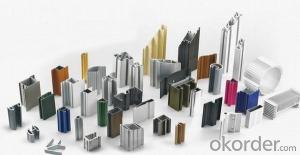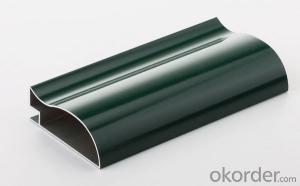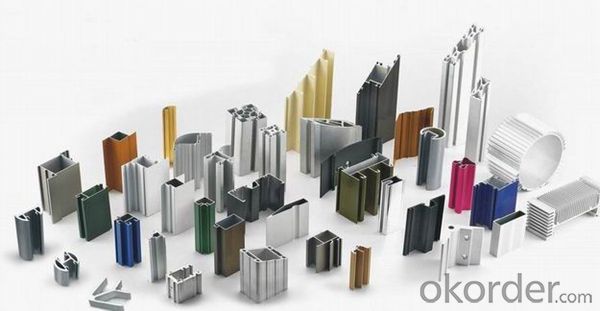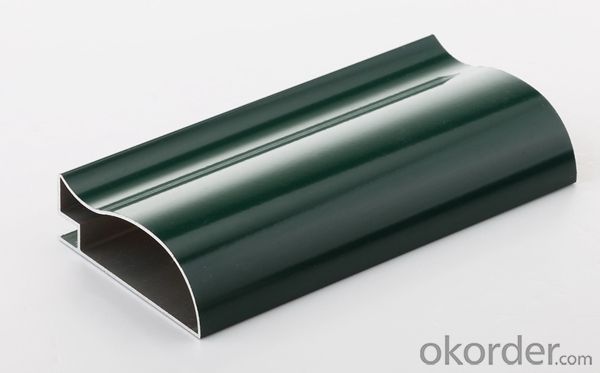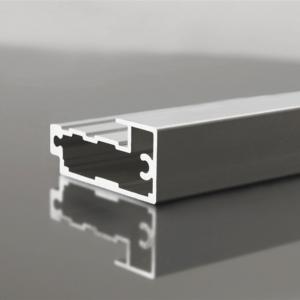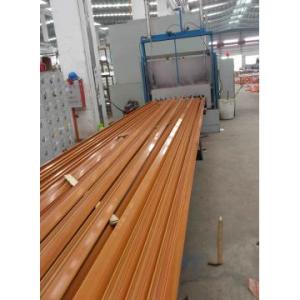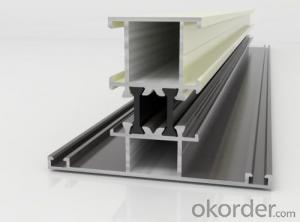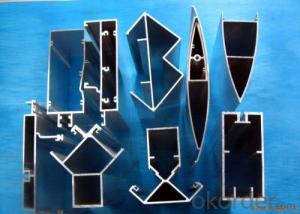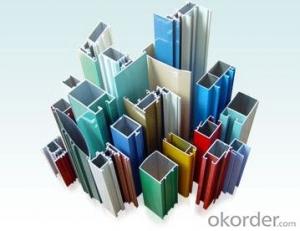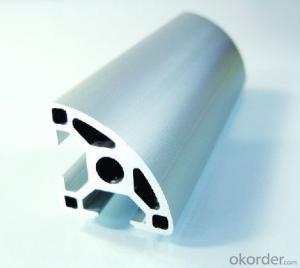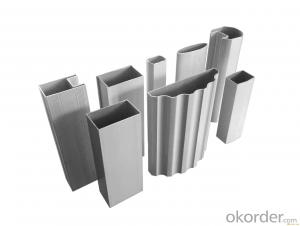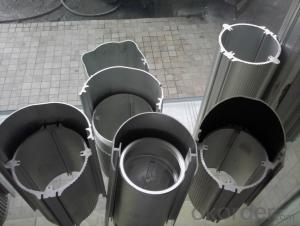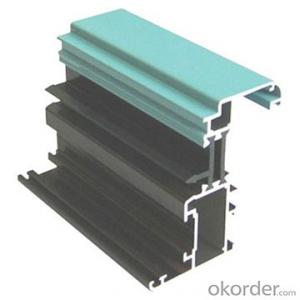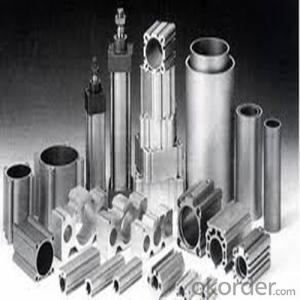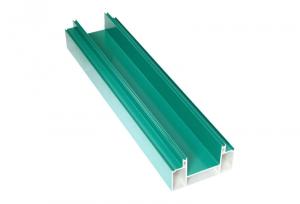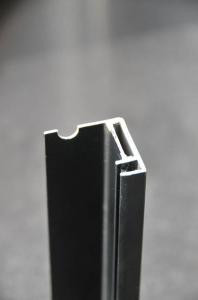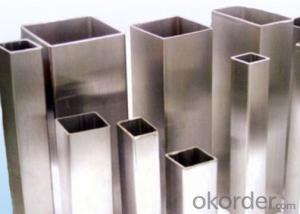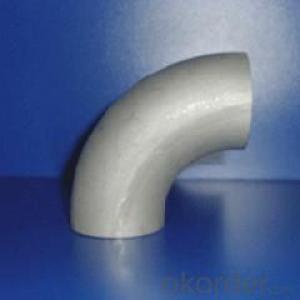Aluminium Extrusion Profile for Windows and Doors China Supplier
- Loading Port:
- Shanghai
- Payment Terms:
- TT OR LC
- Min Order Qty:
- 5 m.t.
- Supply Capability:
- 1000 m.t./month
OKorder Service Pledge
OKorder Financial Service
You Might Also Like
Specification
1. Specification of Aluminium Extrusion Profile for Windows and Doors China Supplier
Alloy | State | Tensile Strength δbMpa | Non-proportional Stretching Stress(δp0.2Mpa) | Stretching rate (δ%) | Pattern Thickness (mm) | HV | HW |
No Less Than | |||||||
6061 | T4/T6 | 180/265 | 110/245 | 16/8 | - | - | - |
6063 | T5/T6 | 160/205 | 110/180 | 8/8 | 0.8/- | 58/- | 8/- |
6063A | T5/T6 | 200,190/230,220 | 160,150/190,180 | 5,5/5,4 | 0.8,0.8/-,- | 65,65/-,- | 10,10/-,- |
2. Application of Aluminium Extrusion Profile for Windows and Doors China Supplier
wall cladding, ceilings, bathrooms, kitchens and balconies, shutters, doors,windows…
3. Feature of Aluminium Extrusion Profile for Windows and Doors China Supplier
Surface Quality :
Be free from Oil Stain, Dent, Inclusion, Scratches, Stain, Oxide Decoration, Breaks, Corrosion, Roll Marks, Dirt Streaks and other defect which will interfere with use,
Mochenical Property:
Chemical Composite and Mechanical Property
4. Certificate:
SGS and ROHS(if client request, paid by client), MTC(plant provided), Certificate of Origin(FORM A, FORM E, CO), Bureau Veritas and SGS (if client request, paid by client), CIQS certificate
5. Image of Aluminium Extrusion Profile for Windows and Doors China Supplier
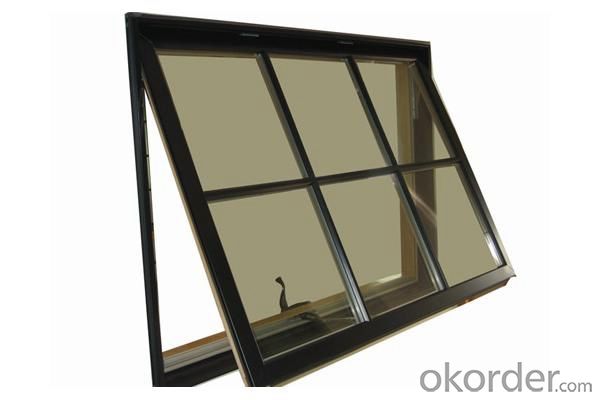
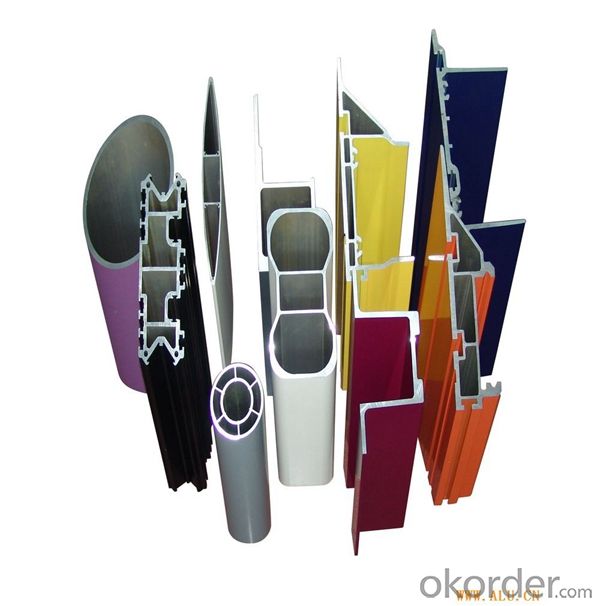

6. Package and shipping of Aluminium Extrusion Profile for Windows and Doors China Supplier
First, plastic cloth with drying agent inside; Second, Pearl Wool; Third, wooden cases with dry agent, fumigation wooden pallets, aluminum surface could cover blue PVC film
7. FAQ
Question 1: What is your MOQ?
We accept one ton per type for an order. But the detail we could negotiate.
Question 2: What is your normal terms of payment?
We always trade with you by T/T. But we also accept the L/C as you require.
Question 3: How many kinds of the surface treatment we can choose?
You could choose different color of powder coated. Anodized of black. matte silver, nature, champagne, bronze color. Mill finished. Wooden finished and printed.etc.
Question 4: Can you supply OEM services?
We offer OEM services for 17 years.
Question 5: How many days for opening the mould?
Normally about 10 days.According to the difficulty of your drawing.
Question 6: Can i choose the package what i want?
Yes, of course. We offer various kinds of package.e.g.PE foam. Shrink film. Wrapping paper.
But we would give you professional suggestion of package.
- Q: Request recommended professional aluminum manufacturer?
- Jing Long aluminum, aluminum strip and aluminum wafer production capacity of 60000 tons, this piece in Shangqiu, still have the strength, is a professional production and processing, wholesale distribution of aluminum, hot-rolled plate, hot rolled plate, aluminum plate, aluminum plate, roll spindle is the main.
- Q: Can aluminum profiles be used for display cases or cabinets?
- Yes, aluminum profiles can definitely be used for display cases or cabinets. Aluminum profiles are lightweight, durable, and have a sleek, modern appearance which makes them a popular choice for displaying products or storing items in cabinets. They can be easily customized and come in various sizes and shapes to meet specific design requirements. Additionally, aluminum profiles are corrosion-resistant, making them suitable for both indoor and outdoor applications. They also offer excellent thermal conductivity, which can be beneficial for controlling temperature in display cases or cabinets. Overall, aluminum profiles provide a versatile and attractive solution for creating display cases or cabinets.
- Q: Can aluminum profiles be used for modular storage systems?
- Yes, aluminum profiles can definitely be used for modular storage systems. Aluminum is a lightweight yet sturdy material that is commonly used in various industries for its durability and versatility. It is particularly well-suited for modular storage systems due to its ability to be easily cut, shaped, and joined together. Aluminum profiles provide a great solution for creating customized storage units that can be easily adjusted or expanded as needed. They can be used to build shelving systems, cabinets, drawers, and other storage components. The modular design allows for easy assembly and disassembly, making it convenient to rearrange or reconfigure the storage system whenever required. Furthermore, aluminum profiles offer excellent corrosion resistance, ensuring that the storage system will remain in good condition even in harsh environments. They are also available in a variety of finishes, allowing for customization to match the desired aesthetic or design requirements. Overall, aluminum profiles provide a cost-effective and durable solution for modular storage systems, offering flexibility, ease of use, and long-lasting performance.
- Q: This question asks for methods to prevent aluminum profiles from rusting during the storage and transportation phases.
- <p>To prevent rusting of aluminum profiles during storage and transportation, follow these steps: 1. Keep the profiles dry and clean, avoiding contact with moisture and corrosive substances. 2. Store them in a cool, dry place, away from direct sunlight and heat sources. 3. Use protective packaging, such as plastic wrapping or anti-corrosion paper, to shield the profiles from moisture and contaminants. 4. Ensure proper ventilation in storage areas to prevent condensation. 5. Avoid stacking profiles directly on the ground; use pallets or racks to elevate them and allow air circulation. 6. Regularly inspect the profiles for signs of corrosion and address any issues promptly. By implementing these measures, you can significantly reduce the risk of rusting during storage and transportation.</p>
- Q: How can I distinguish aluminum from aluminium oxide or electrophoresis aluminum or spray aluminium material?
- Aluminum oxide in oxidation process does not cause changes in the thickness of aluminum,The electrophoretic aluminum material is to deposit a coating film on the surface of the profile in the condition of direct current and direct current, which will increase the thickness of the aluminum
- Q: Can aluminum profiles be used in display shelving and racking systems?
- Yes, aluminum profiles can definitely be used in display shelving and racking systems. Aluminum is a versatile and lightweight material that offers several advantages for these applications. Its strength-to-weight ratio makes it ideal for constructing sturdy and durable shelving and racking systems. Aluminum profiles can be easily customized and fabricated to meet specific design requirements, allowing for flexibility in creating different shelving configurations. Additionally, aluminum is corrosion-resistant, which is particularly beneficial in environments where moisture or chemicals may be present. The sleek and modern appearance of aluminum profiles also adds an aesthetic appeal to display shelving and racking systems. Overall, aluminum profiles are a popular choice for these applications due to their strength, versatility, and aesthetic qualities.
- Q: Can aluminum profiles be used for swimming pool covers?
- Yes, aluminum profiles can be used for swimming pool covers. Aluminum is a durable and lightweight material that is resistant to corrosion, making it suitable for outdoor applications like swimming pool covers. Additionally, aluminum profiles can be easily customized to fit the specific dimensions and design requirements of the pool cover.
- Q: What are the different cutting methods for aluminum profiles?
- There are several cutting methods for aluminum profiles, including sawing, shearing, milling, and laser cutting. Sawing is commonly used for straight cuts and can be done manually or with a powered saw. Shearing involves using sharp blades to cut through the aluminum, typically for thin profiles. Milling involves using a rotating cutter to remove material and create complex shapes. Laser cutting uses a high-powered laser beam to melt or vaporize the aluminum, offering precise and clean cuts. The choice of cutting method depends on the desired shape, thickness, and accuracy required for the aluminum profiles.
- Q: How do aluminum profiles perform in terms of sound transmission loss?
- Aluminum profiles have gained a reputation for their outstanding ability to reduce sound transmission. This is due to their dense and rigid composition, which effectively impedes and diminishes the propagation of sound waves. The inherent characteristics of aluminum, including its high density and minimal resonance, make it an optimal material for sound insulation purposes. Moreover, the flexibility to customize aluminum profiles with different shapes and thicknesses allows for even greater enhancement of their soundproofing capabilities. Consequently, aluminum profiles are highly sought after for situations where noise reduction is a priority, such as in the construction of buildings, automotive manufacturing, and HVAC systems.
- Q: Are aluminum profiles suitable for exhibition displays?
- Exhibition displays can benefit greatly from the use of aluminum profiles. This material is both lightweight and durable, making it perfect for constructing modular structures that can be effortlessly transported and assembled at various exhibition venues. These profiles are versatile and can be employed to build display walls, stands, booths, and other components of an exhibition. One major advantage of using aluminum profiles for exhibition displays lies in their adaptability. They can be easily modified and adjusted to meet specific design requirements, enabling the creation of unique and captivating displays. Furthermore, aluminum profiles can be easily connected and disassembled, which makes them a practical choice for exhibitions that demand frequent setup and teardown. Another benefit of utilizing aluminum profiles for exhibition displays is their visual appeal. Aluminum has a sleek and modern appearance that can enhance the overall impact of an exhibition. It can also be finished with various coatings or colors to match the branding or theme of the event, further augmenting the overall presentation. Additionally, aluminum profiles offer exceptional stability and strength, ensuring that exhibition displays can withstand the demands of a bustling exhibition environment. They are also resistant to corrosion, which is crucial when considering the longevity and durability of the display. In conclusion, aluminum profiles are a suitable option for exhibition displays due to their lightweight nature, durability, versatility, aesthetic appeal, and strength. They provide the necessary stability and can be easily customized to create visually appealing and functional exhibition displays.
Send your message to us
Aluminium Extrusion Profile for Windows and Doors China Supplier
- Loading Port:
- Shanghai
- Payment Terms:
- TT OR LC
- Min Order Qty:
- 5 m.t.
- Supply Capability:
- 1000 m.t./month
OKorder Service Pledge
OKorder Financial Service
Similar products
Hot products
Hot Searches
Related keywords
